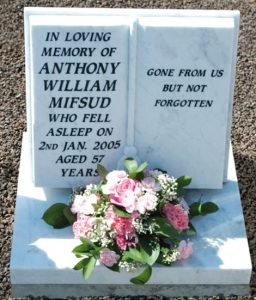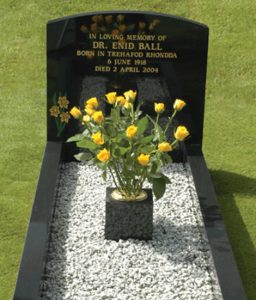How to choose a headstone
Taking your time
Choosing a headstone can feel like a daunting task when you’re newly bereaved. The first thing you should know is that there’s no rush to make a decision. A headstone serves as a timeless tribute to the deceased and while you’re still in the early stages of the grieving process your thoughts are bound to be clouded by sadness. It’s often better to allow some time to pass – even if that’s several years – so you can think more clearly about how you’d like your loved one to be remembered.
Church or cemetery burial?
When you’re ready to think about a headstone, bear in mind that your choice may be restricted according to whether the burial was in a church or cemetery. Generally you’ll find that cemeteries don’t have hard-and-fast rules and regulations. However, with churchyards there will be limitations. These will be dependent on the branch of the church and the local parish, but commonly include only allowing inscriptions that refer to Christianity, avoiding any reflective materials and finishes and not using bold colouring.
Deciding on a design
One of the first decisions you’ll need to make is on the style of headstone. The most traditional design is the upright headstone, which is usually made from granite, limestone or marble. A smaller upright version is called a ‘desk tablet’ – also known as a DVT (Desk Vase Tablet). You can also have a ground-level flat headstone in granite or bronze or a ‘kerbed’ or ‘ledger slab’, which is a full-length, ground-level headstone.
Selecting the stone
Headstones come in a range of materials including slate, granite and limestone. There’s also white marble and bronze, though neither of these are permitted in churchyards. As well as the overall look, you’ll need to consider things such as durability, how clearly it will show an inscription, weather resistance and what kind of cleaning and maintenance it will require. And of course cost will be a factor. Granite is a popular choice as it’s a cheap option, highly durable and comes in different colours and finishes.
Finding the right finish
As well as the material, you’ll also need to choose a finish – and with this there are three options. A polished finish looks beautifully smooth and shiny, but the downsides are that it won’t be allowed by most churches and it will also need regular cleaning. Another choice is part-polished, where only the base and inscription is polished. Then there’s honed, a church-friendly smooth but unreflective finish.
Composing a lasting inscription
The inscription includes the name of the deceased and their date of birth and death, along with an epitaph. Finding the right words can be the hardest part, which is another good reason not to rush things. Headstone engraving tends to be charged per letter or per word, so an epitaph will usually be fairly short and concise. You might want to choose something simple, such as ‘Gone but not forgotten’ or ‘Until we meet again’. Some people prefer a Bible passage, the verse of a poem or a memorable quote.
* We’re here to help you with all aspects of burial or cremation. Please contact us on 01438 316623. You can see more examples of stone designs on our memorial page.





